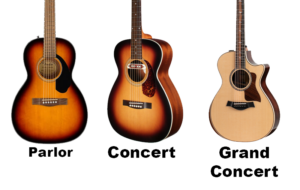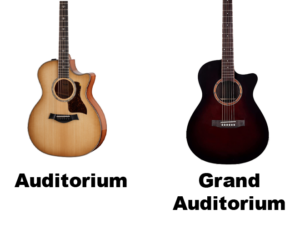Uncategorized
How to Play THE BEATLES’ “Come Together” on the 3-String Guitar
Tune up, plug in, and rock out to one of the Beatles’ most classic and riff-laden masterpieces. This arrangement is specifically for the 3-string guitar and was arranged to be played using a finger slide. It can, however, be played note-by-note whether you use a slide, or fret the notes without a slide.
The Tablature below corresponds to the video performance above.
The tuning for this song is Open G Tuning (G-D-G). To achieve this tuning, string your 3-string guitar up with the A, D, & G string from a standard 6-string guitar pack, and tune the strings to the notes G-D-G.
The key to playing this song correctly, is to think of it as two separate guitar parts that are being played simultaneously. The right-hand thumb is playing a bassline on each downbeat, and the rest of the fingers on the right hand pick the melody notes. It’s important to isolate the two parts and practice them separately in order to master this technique. This style of playing a melody and bassline simultaneously is popular in the “Mississippi Hill Country Blues” style of picking. To check out a complete lesson on this style CLICK HERE.
Thanks for keeping the Roots alive, and don’t forget to click “FOLLOW” on the right-hand side of this page to stay up-to-date with new lessons and articles!
The 3-String Guitar used in this video lesson was crafted by:
Bill Turner of Wunkywerks Guitars
Etsy Store: https://www.etsy.com/shop/WunkywerksGuitars
Email: Wunkywerksguitars@gmail.com

Uncategorized
Acoustic Guitar Sizes: Finding Your Perfect Fit
Have you ever wondered how the size of an acoustic guitar affects its sound? From the intimate, focused tones of a parlor guitar to the deep, resonant sound of a jumbo, the size and shape of an acoustic guitar can have a profound impact on its sonic characteristics.”
In this article, we’ll explore acoustic guitar sizes, their variations, and how to choose the perfect size that suits your needs.
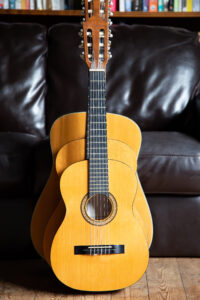 Understanding Acoustic Guitar Sizes: A Musical Puzzle
Understanding Acoustic Guitar Sizes: A Musical Puzzle
Acoustic guitar sizes refer to the dimensions and proportions of the guitar body, which significantly influence the instrument’s tonal characteristics, projection, and playability.
Just like pieces of a musical puzzle, different sizes create distinct voices that cater to various playing styles and preferences.
The Spectrum of Acoustic Guitar Sizes
Acoustic guitars come in several sizes, each with its unique qualities and attributes. Let’s explore some common acoustic guitar sizes and their defining features:
-
-
Parlor Guitar: The parlor guitar is petite and charming, making it an ideal companion for intimate settings.
The name comes from the rooms in which the guitar was typically played in the late 19th century.
Some famous musicians who have been known to use the parlor guitar are, Eric Clapton, Mark Orton, Ed Sheehan, and John Mayer
Its smaller size results in a focused and balanced sound, perfect for fingerpicking and folk music.
-
Concert Guitar: Slightly larger than the parlor guitar, the concert guitar offers enhanced projection and volume. It strikes a balance between portability and sound, making it versatile for various genres.
It is often used in classical music and flamenco music with its full sound.
-
Grand Concert Guitar: With a larger body than the concert guitar, the grand concert guitar boasts a fuller sound and improved tonal complexity.
A popular choice for those who have a smaller stature and require an instrument that’s built to a shorter scale. Great choice for traveling musicians who often play live performances.
It’s suitable for fingerstyle playing and intricate arrangements.
-
Auditorium Guitar: The auditorium guitar, also known as the orchestra model (OM), features a well-rounded sound with a pronounced midrange.
More shallower than the dreadnought and narrower in width than a concert guitar. An Auditorium guitar brings the body closer to the player, making it feel more intimate and comfortable for stage use.
Some famous musicians who play it include Ed Sheeran, John Mayer, and Eric Clapton.
-
Grand Auditorium Guitar: Expanding on the auditorium guitar’s design, the grand auditorium guitar offers a versatile sound profile with enhanced bass response and overall volume.
It is a versatile mid-sized guitar that is a good choice for those who want a single guitar to travel with. The tone is great for strumming and picking. It performs well on stage and in the studio.
It suits a wide range of musical genres.
-
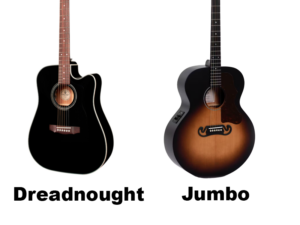 Dreadnought Guitar: The Dreadnought is a true icon, known for its bold and powerful sound. Its large body produces a strong bass response, making it ideal for strumming and vocal accompaniment.
Dreadnought Guitar: The Dreadnought is a true icon, known for its bold and powerful sound. Its large body produces a strong bass response, making it ideal for strumming and vocal accompaniment.This guitar is known for its powerful voice and lower-mid-rich tones that make it a favored choice for country artists. Although it is a popular choice for musicians of all genres.
Some famous musicians who play the dreadnought guitar include Hank Williams Jr, Elvis Presley, Keith Richards, Thom Yorke, and Kurt Cobain.
The original dreadnought guitars were made for the Oliver Ditson Company and featured mahogany backs and sides and spruce tops.
-
Jumbo Guitar: The jumbo guitar lives up to its name with a massive body that delivers robust volume and a deep bass presence.
This is the largest of the guitar family with a deeper body than the popular dreadnought. The body is wider and deeper than traditional acoustic guitars, which gives them a unique appearance.
Jumbo’s are well suited to rhythm guitarists in country and folk rock, and produce a deep rich sound favored by heavy strummers. Some famous musicians who play this guitar are Elvis Presley, George Harrison of the Beatles, Neil Young, Sheryl Crow, and Pete Townshend of The Who.
Choosing the Right Acoustic Guitar Size for You
Selecting the right acoustic guitar size involves considering factors such as playing style, comfort, and tonal preferences. Here are some steps to guide you on your quest:
-
Identify Your Playing Style: Determine whether you lean towards fingerpicking, strumming, or a mix of both. Different sizes excel in different playing styles, so choose one that complements your technique.
-
Consider Body Comfort: Hold and play guitars of various sizes to assess comfort. A guitar that fits well against your body ensures a pleasant playing experience, especially during extended sessions.
-
Evaluate Sound Preferences: Listen to the sound produced by different acoustic guitar sizes. Pay attention to tonal qualities, such as warmth, brightness, and projection, to find the one that resonates with your musical taste.
The Influence of Acoustic Guitar Sizes on Music
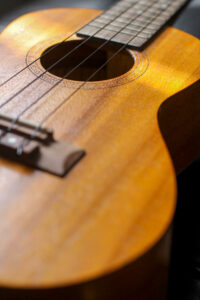 Acoustic guitar sizes and shapes can have a significant impact on the sound of the instrument.
Acoustic guitar sizes and shapes can have a significant impact on the sound of the instrument.The size of the guitar body type also relates to the volume of air within the instrument. Changes to the air capacity of the body will emphasize specific frequencies. A smaller body will have a more focused sound centered on higher frequencies, while a larger body will produce deeper low-end frequencies.
Body dimensions can provide some indication of the tone you might expect, but other factors exert a profound influence, too. Much depends on the tonewoods used to construct the body and the shape, size, and layout of the braces.
Finding Harmony in Acoustic Guitar Sizes
By delving into the nuances of size, sound, and playability, you’ve gained insights that will guide you toward the perfect fit for your musical aspirations.
As you continue your exploration, remember that each acoustic guitar size has its own unique voice and character. Embrace the joy of trying different sizes, celebrate the nuances of their sounds, and let your heart lead you to the one that resonates with your musical soul.
-
Uncategorized
Exploring the Enchanting C#maj7 Guitar Chord: Your Gateway to Musical Elegance
Greetings, fellow guitar enthusiasts and curious learners! Are you ready to embark on a musical journey that unveils the captivating world of the C#maj7 guitar chord? Today, we’re delving into the enchanting universe of the C#maj7 chord – a harmonious gem that adds sophistication and allure to your musical toolbox. Whether you’re an aspiring guitarist eager to expand your chord repertoire or a curious soul seeking to understand the intricacies of harmony, this guide will take you through the captivating realm of the “C#maj7 Guitar Chord.” So, grab your guitar, find a cozy spot, and let’s explore the harmonious tapestry of musical expression and creativity!
Unveiling the C#maj7 Chord: A Gateway to Musical Splendor
Imagine the C#maj7 chord as a musical key that unlocks a realm of melodic wonders. This chord’s unique tonal quality adds a touch of elegance and richness to your music, making it a versatile choice across various musical genres. Just as an artist selects the perfect brushstroke, the C#maj7 chord allows you to paint your sonic canvas with notes that evoke emotion and creativity.
Mastering the C#maj7 Chord: Crafting Harmonic Brilliance
Let’s delve into the mechanics of forming the C#maj7 chord on your guitar. Follow these steps:
1. Finger Placement: Begin by placing your index finger on the 1st fret of the B string (the second thinnest string), marking the root note (C#).
2. Middle Finger: Position your middle finger on the 2nd fret of the D string (the fourth thickest string), forming the major third (E# or F).
3. Ring Finger: Place your ring finger on the 3rd fret of the G string (the third thinnest string), creating the perfect fifth (G#).
4. Pinky Finger: Finally, use your pinky finger to press down on the 4th fret of the high E string (the thinnest string), adding the major seventh (B).
5. Strumming: Focus on strumming the G, B, and high E strings (the third, second, and first strings) while avoiding the low E string (the thickest string).
6. Sound Check: Strum the strings individually to ensure each note rings out clearly. Adjust finger placement if needed for a resonant sound.
Exploring C#maj7 Chord Variations: Adding Flavor
While the C#maj7 chord is inherently captivating, you can add variations to enhance its sonic potential. Here are a couple of ways to experiment:
1. Fingerpicking Patterns: Delve into fingerpicking techniques to create intricate patterns that highlight the individual notes of the C#maj7 chord.
2. Arpeggios: Practice playing the notes of the C#maj7 chord individually in a sequence, creating arpeggios that cascade like a gentle waterfall.
The C#maj7 Chord in Action: Musical Styles
The C#maj7 chord’s elegance and versatility make it a favorite choice for songs that demand both sophistication and depth. Here are a few popular songs that feature the C#maj7 chord:
1. “Breezin'” by George Benson: This jazz-infused tune showcases the C#maj7 chord’s harmonic richness and smooth allure.
2. “I’m Yours” by Jason Mraz: The C#maj7 chord contributes to the breezy and feel-good vibe of this acoustic pop hit.
Tips for Mastering the C#maj7 Chord
As you embark on your journey to master the C#maj7 chord, consider these tips to enhance your playing:
1. Practice Regularly: Dedicate focused practice time to build muscle memory and finger strength for the C#maj7 chord.
2. Smooth Chord Transitions: Work on transitioning smoothly between the C#maj7 chord and other chords to improve your overall playing fluency.
3. Experiment with Dynamics: Play the C#maj7 chord with varying degrees of intensity to explore its full range of tonal expression.
Conclusion: Embrace the Elegance of the C#maj7 Chord
Congratulations, you’ve embarked on a harmonious journey through the captivating world of the C#maj7 guitar chord. As you strum, experiment with variations, and play songs, you’ll discover the power of this chord to infuse your music with elegance, depth, and resonance. Keep practicing, keep exploring, and keep embracing the enchanting allure of the C#maj7 chord. It’s your key to a world of musical expression, where each note resonates with sophistication and allure. So, pick up your guitar, let your fingers dance across the strings, and let the captivating world of the C#maj7 chord lead you toward a realm of melodies that enchant the senses and elevate the soul, one harmonious note at a time!
Uncategorized
Mastering the Art of Music: Exploring Guitar Techniques
In the world of music, the guitar stands as a versatile and captivating instrument, capable of producing an array of sounds that range from soothing melodies to electrifying solos. Behind the magic of a skillful guitarist lies a treasure trove of guitar techniques – the secret ingredients that bring music to life. Whether you’re a beginner or a seasoned player, understanding and mastering these guitar techniques can elevate your playing and open the door to endless musical possibilities. In this article, we’ll embark on a journey to explore various guitar techniques, their significance, and how you can incorporate them into your musical repertoire. So, let’s dive into the world of guitar techniques and uncover the secrets of musical artistry!
The Dance of Fingers: An Introduction to Guitar Techniques
Guitar techniques are the building blocks of musical expression, allowing players to create unique sounds, textures, and emotions. By mastering these techniques, guitarists can infuse their music with a range of dynamics, styles, and tones.
Exploring Essential Guitar Techniques
Let’s take a closer look at some essential guitar techniques that every player should explore:
1. Strumming: Strumming involves rhythmically brushing your fingers or a pick across the strings to produce a steady flow of sound. It forms the foundation of many songs and is a fundamental skill for players of all levels.
2. Fingerpicking: Fingerpicking is a technique where individual fingers pluck the strings to create intricate melodies and harmonies. This technique is commonly used in folk, classical, and acoustic guitar genres.
3. Hammer-ons and Pull-offs: These techniques involve adding notes to a melody or chord progression by quickly tapping a finger onto a fret (hammer-on) or pulling a finger off a string (pull-off). They enhance fluidity and speed in playing.
4. Bending: Bending involves pushing a string upwards or downwards to change its pitch, creating expressive and emotive sounds. It’s a hallmark technique in rock and blues genres.
5. Vibrato: Vibrato adds a shimmering effect to a note by rapidly oscillating the pitch up and down. It infuses melodies with warmth and adds a touch of personal style.
6. Slide: Using a slide (typically a metal or glass tube), players glide along the strings, producing smooth and gliding notes. Slide guitar is a cornerstone of blues and rock music.
7. Tapping: Tapping involves tapping the fretboard with your fingers to produce quick and intricate patterns of notes. This technique is commonly associated with virtuosic solos.
8. Palm Muting: By resting the palm of your hand lightly on the strings while strumming, you create a muted and percussive sound that adds rhythmic texture to your playing.
9. Alternate Picking: Alternate picking is a method where you alternate between downward and upward strokes with your picking hand. It’s essential for achieving speed and precision in your playing.
Unlocking the Power of Guitar Techniques
Here’s how you can unlock the power of guitar techniques and incorporate them into your playing:
1. Practice Regularly: Dedicate time to practice each technique individually. Focus on accuracy, speed, and control to build muscle memory.
2. Start Slow: When learning a new technique, start at a slow tempo and gradually increase the speed as you become more comfortable.
3. Combine Techniques: Experiment with combining different techniques within a single piece of music. This adds depth and complexity to your playing.
4. Listen and Learn: Study recordings of your favorite guitarists to observe how they incorporate techniques into their playing. Emulate their approach while adding your unique touch.
5. Explore Genres: Different genres of music showcase various techniques. Explore different genres to expand your repertoire of techniques and musical styles.
The Transformative Impact of Guitar Techniques
Guitar techniques are the keys that unlock the door to musical expression. They enable players to convey emotions, tell stories, and create sonic landscapes that captivate listeners. Just as a painter uses a palette of colors to create a masterpiece, guitarists use a palette of techniques to craft musical art.
Conclusion: Guitar Techniques, Your Path to Musical Mastery
Congratulations, you’ve embarked on a journey of discovery through the realm of guitar techniques! By delving into the intricacies of strumming, fingerpicking, bending, and a multitude of other techniques, you’ve gained insights that will shape your musical journey.
As you continue to explore and refine these techniques, remember that patience, practice, and passion are the keys to mastery. Embrace the joy of experimenting with different techniques, celebrate your progress, and let your musical curiosity guide you forward.
With each note you play, you’re painting a musical masterpiece that resonates with your individuality and creative spirit. So, pick up your guitar, let your fingers dance across the strings, and let the magic of guitar techniques transport you to a world of musical artistry. Happy playing!
-
advanced9 years ago
How to Play “Sleepwalk” on the 3-String Guitar! Guitar TABs Included!
-
beginner8 years ago
3-String or 4-String? How to Decide Which is Right for You!
-
Blues Guitar8 years ago
Go-To Tunings for Blues Slide Guitar
-
advanced8 months ago
Fun and Effective Guitar Exercises: Elevate Your Playing with These 5 Simple Techniques
-
beginner8 months ago
Exploring Different Guitar Types: A Beginner’s Guide
-
Blues Guitar7 years ago
Jack Daniel’s Whiskey Barrel Guitar: How It’s Made and What it Sounds Like
-
Guitars8 months ago
Bass vs Guitar: Exploring the Musical Journey
-
Uncategorized8 months ago
Acoustic Guitar Sizes: Finding Your Perfect Fit
